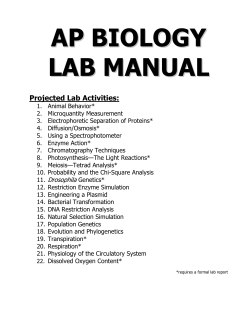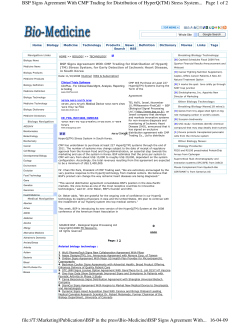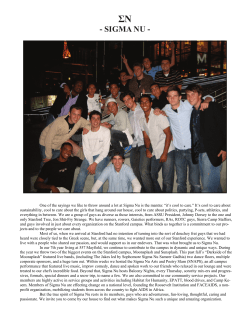
What is Systems Biology? Where does it come from ?
What is Systems Biology? Where does it come from ? What are the challenges ahead? Nicolas Le Novère, Babraham Institute, EMBL-EBI What did electrical engineering bring? O F D O R T V A O W L E E H K R H T L A M O C N U F What will biological engineering bring? FOOD HEALTH (drug production regenerative medicine) ENVIRONMENT (biofuels decontamination) (crop) SECURITY (biosensors) Why using mathematical models? Describe 1917 Why using mathematical models? Describe 1917 Explain 1952 Why using mathematical models? Describe 1917 Explain 1952 Predict 2000 What is a mathematical model? Wikipedia (April 17th 2013): “A mathematical model is a description of a system using mathematical concepts and language.” What is a mathematical model? Wikipedia (April 17th 2013): “A mathematical model is a description of a system using mathematical concepts and language.” variables [x] Vmax Kd EC50 length t1/2 What is a mathematical model? Wikipedia (April 17th 2013): “A mathematical model is a description of a system using mathematical concepts and language.” variables relationships [x] Vmax Kd EC50 length t1/2 If then What is a mathematical model? Wikipedia (April 17th 2013): “A mathematical model is a description of a system using mathematical concepts and language.” variables relationships constraints [x] [x]>0 Vmax Energy conservation Kd Boundary conditions (v < upper limit) EC50 Objective functions (maximise ATP) length t1/2 If then Initial conditions What is a mathematical model? Wikipedia (April 17th 2013): “A mathematical model is a description of a system using mathematical concepts and language.” variables relationships constraints [x] [x]>0 Vmax Energy conservation Kd Boundary conditions (v < upper limit) EC50 Objective functions (maximise ATP) length t1/2 If then Initial conditions Different types: Dynamical models, logical models, rule-based models, multi-agent models, statistical models, etc. Emergence of the notion of system XXI Description of interacting components XX Description of the components of the world XIX XVIII Global Description of the world XVII “classical” mechanics, anatomy, physiology XVI Statistical physics, thermodynamics, quantum mechanic, biochemistry, structural biology, molecular biology Cybernetics, Information theory, telecommunications, automata, multi-agents, Systems Biology Systems are formalised mid-XXth Systems are formalised mid-XXth “[A system consists of] a dynamic order of parts and processes standing in mutual interaction. [...] The fundamental task of biology [is] the discovery of the laws of biological systems" Ludwig von Bertalanfy, Kritische Theorie der Formbildung, 1928 The three paradigms of Biology Systems Biology XXI 2000 OMICS Molecular Biology XX Recombinant DNA Eccles/Katz 1950 XIX Physiology Monod/Jacob Watson/Crick Avery Hill/Meyerhoff Kossel XVIII 1900 Michaelis/Menten Pavlov/Langley XVII XVI 1850 Claude Bernard MCA/BST Hodgkin/Huxley Computer simulations Vs. mathematical models Computer simulations Vs. mathematical models One would like to be able to follow this more general process mathematically also. The difficulties are, however, such that one cannot hope to have any very embracing theory of such processes, beyond the statement of the equations. It might be possible, however, to treat a few particular cases in detail with the aid of a digital computer. This method has the advantage that it is not so necessary to make simplifying assumptions as it is when doing a more theoretical type of analysis. Birth of Computational Systems Biology R.I.P. 30 May 2012 Cambridge The Computational Systems Biology loop “biological” model validation simulation mathematical model parameterisation computational model Towards Systems Biology XXI 2000 2000 XX 1990 1950 XIX 1980 XVIII 1970 1900 XVII 1960 XVI 1850 1950 Towards Systems Biology XXI 2000 2000 XX 1990 1950 XIX 1980 XVIII Signalling pathways Gene regulatory networks Cell cycle Goldbeter/Koshland Covalent cascades Metabolic networks 1970 1900 XVII 1960 XVI 1850 1950 Denis Noble Heart pacemaker Hodgkin/Huxley models Towards Systems Biology Organ level XXI 2000 2000 XX 1990 1950 XIX 1980 XVIII Tissue models Signalling pathways Gene regulatory networks Purkinje neuron Cell cycle Goldbeter/Koshland Covalent cascades Metabolic networks Simple circuits Complex neurons 1970 1900 XVII 1960 Denis Noble Heart pacemaker Rall's cable approximation neurobiology XVI 1850 1950 Hodgkin/Huxley models 60s and 70s Mihajlo Mesarovic: 1966 Symposium “general systems theory and biology Stuart Kaufmann, Rene Thomas: 1969-73 boolean networks for gene regulation Henri Kacser: Metabolic control analysis, Michel Savageau: Biochemical Systems Theory Towards Systems Biology Organ level SBML XXI 2000 2000 XX 1990 1950 XIX 1980 XVIII Tissue models Signalling pathways Gene regulatory networks Purkinje neuron Cell cycle Goldbeter/Koshland Covalent cascades Metabolic networks Simple circuits Complex neurons 1970 1900 XVII 1960 Stochastic algorithms MCA/BST Boolean networks Denis Noble Heart pacemaker Rall's cable approximation neurobiology XVI 1850 1950 User-friendly simulators Multi-agent systems Hodgkin/Huxley models methods 80s: The reign of Molecular Biology 90s: maturation of the community Publication of modelling work in high visibility journals, e.g.: Tyson. modeling the cell-division cycle - cdc2 and cyclin interactions. PNAS 1991; McAdams and Shapiro. Circuit simulation of genetic networks. Science 1995; Barkai and Leibler. Robustness in simple biochemical networks. Nature 1997; Neuman et al. Hepatitis C viral dynamics in vivo and the antiviral efficacy of interferon-alpha therapy. Science 1998; Yue et al. Genomic cis-regulatory logic: Experimental and computational analysis of a sea urchin gene . Science 1998; Bray et al. Receptor clustering as a cellular mechanism to control sensitivity. Nature 1998; Bhalla ad Iyengar. Emergent properties of signaling pathways. Science 1998 Structuring of the community modelling metabolism Large-scale modelling and simulation projects E-Cell project 1996; The Virtual Cell 1998 Availability of high-throughput data on parts and interactions Two-hybrids (1989); microarrays (1995) etc. Large-scale funding for wet+dry studies of biological systems Alliance For Cellular Signalling (http://www.afcs.org/). First of the NIH “glue grants”. 1998 Towards Systems Biology Organ level SBML XXI 2000 2000 XX 1990 1950 XIX 1980 XVIII Purkinje neuron Cell cycle Goldbeter/Koshland Covalent cascades Metabolic networks Complex neurons Stochastic algorithms MCA/BST Boolean networks Denis Noble Heart pacemaker Rall's cable approximation neurobiology XVI 1850 1950 User-friendly simulators Multi-agent systems Simple circuits 1970 1900 XVII 1960 Barabasi Tissue models Signalling pathways Gene regulatory networks Hodgkin/Huxley models Repressilator methods Towards Systems Biology Synthetic Synthetic Biology Biology Organ level SBML XXI 2000 2000 XX 1990 1950 XIX 1980 XVIII Purkinje neuron Cell cycle Goldbeter/Koshland Covalent cascades Metabolic networks Complex neurons Stochastic algorithms MCA/BST Boolean networks Denis Noble Heart pacemaker Rall's cable approximation neurobiology XVI 1850 1950 User-friendly simulators Network Network Multi-agent systems Simple circuits 1970 1900 XVII 1960 Barabasi Tissue models Signalling pathways Gene regulatory networks Hodgkin/Huxley models Repressilator methods Biology Biology Formal revival of Systems Biology “Modelling” Systems Biology 1998 - Hiroaki Kitano founds the Systems Biology Institute in Tokyo First appearance: Kyoda, Kitano. Virtual Drosophila project: Simulation of drosophila leg formation. Genome Informatics Series (1998) Kitano, H. Perspectives on systems biology. New Generation Computing Volume 18, Issue 3, 2000, Pages 199-216 “Network” Systems Biology First appearance: Leroy Hood. Systems biology: new opportunities arising from genomics, proteomics and beyond. Experimental Hematology. Volume 26, Issue 8, 1998, Page 681 Schwikowski B, Uetz P, Fields S. A network of protein-protein interactions in yeast. Nat Biotechnol. 2000 Dec;18(12):1257-61. 2000 - Leroy Hood founds the Systems Biology Institute in Seattle Rise of Systems Biology as a paradigm 2007 XXI 2000 2000 2006 XX 2005 1990 2004 1950 XIX 2003 1980 2002 XVIII 1970 2001 1900 2000 XVII 1960 1999 XVI 1998 1850 1950 Rise of Systems Biology as a paradigm 2007 XXI 2000 2000 2006 XX 2005 1990 2004 1950 XIX 2003 1980 ERASysBio SystemsX Systems Biology Enters FP6 hepatosys YSBN 2002 XVIII 1970 2001 1900 2000 XVII 1960 1999 Alliance for Cellular Signaling ERATO-Kitano XVI 1998 1850 1950 projects Rise of Systems Biology as a paradigm 2007 XXI 2000 2000 2006 XX 2005 1990 2004 1950 XIX 2003 1980 ERASysBio SystemsX Systems Biology Enters FP6 hepatosys YSBN Choi Boogerd Grierson Palsson BMC Sys Bio Alon Szallasi Kriete MSB Klipp Kaneko IEE Sys Bio SBML Science special issue 2002 XVIII 1970 2001 1900 2000 XVII 1960 1999 Alliance for Cellular Signaling ERATO-Kitano “Foundations of Systems Biology” Ideker/Hood Von Dassow “Computational Cell Biology” ECell XVI 1998 1850 1950 projects publications Rise of Systems Biology as a paradigm 2007 XXI 2000 2000 2006 XX 2005 1990 2004 1950 XIX 2003 1980 ERASysBio SystemsX Systems Biology Enters FP6 hepatosys YSBN Choi Boogerd Grierson Palsson BMC Sys Bio Alon Szallasi Kriete MSB Klipp Kaneko 6 BBSRC centres IEE Sys Bio BioQuant SBML Science special issue 2002 XVIII 1970 2001 1900 2000 XVII 1960 1999 Alliance for Cellular Signaling ERATO-Kitano “Foundations of Systems Biology” Ideker/Hood Tokyo Systems Biology Institute Von Dassow “Computational Cell Biology” Seattle Institute for Systems Biology ECell XVI 1998 1850 1950 projects publications Institutes Rise of Systems Biology as a paradigm 2007 XXI 2000 2000 2006 XX 2005 1990 2004 1950 XIX 2003 1980 ERASysBio SystemsX Systems Biology Enters FP6 hepatosys YSBN Choi Boogerd Grierson Palsson BMC Sys Bio Alon Szallasi Kriete MSB Klipp Kaneko End End of of BBSRC BBSRC Systems Systems Biology Biology calls calls 6 BBSRC centres IEE Sys Bio BioQuant SBML Science special issue 2002 XVIII 1970 2001 1900 2000 XVII 1960 1999 Alliance for Cellular Signaling ERATO-Kitano “Foundations of Systems Biology” Ideker/Hood Tokyo Systems Biology Institute Von Dassow “Computational Cell Biology” Seattle Institute for Systems Biology ECell XVI 1998 1850 1950 projects publications Institutes But what is Systems Biology??? Molecular and Cellular Biology Describes and quantify Level N A B properties But what is Systems Biology??? Molecular and Cellular Biology Describes and quantify Level N A B properties A B properties C Level N+1 Describes and quantify Physiology But what is Systems Biology??? Molecular and Cellular Biology Describes and quantify A Level N B properties explains Systems Biology C Level N+1 A affects B properties Describes and quantify Physiology But what is Systems Biology??? Molecular and Cellular Biology Describes and quantify A Level N B properties explains Systems Biology C Level N+1 A affects B properties NOT UNIQUE! Describes and Several systems structures quantify may generate the same properties Physiology What Systems Biology is not! Purely theoretical: Most systems biologists are actually experimental biologists What Systems Biology is not! Purely theoretical: Most systems biologists are actually experimental biologists Based on large datasets: in a system of two enzymes, the behaviour of both reactions is different than the ones observed in isolation What Systems Biology is not! Purely theoretical: Most systems biologists are actually experimental biologists Based on large datasets: in a system of two enzymes, the behaviour of both reactions is different than the ones observed in isolation Focused on biomolecular systems: systems biology is scale-free, and a biological system can be made up of molecules, cells, organs or individuals What Systems Biology is not! Purely theoretical: Most systems biologists are actually experimental biologists Based on large datasets: in a system of two enzymes, the behaviour of both reactions is different than the ones observed in isolation Focused on biomolecular systems: systems biology is scale-free, and a biological system can be made up of molecules, cells, organs or individuals Systems Biology is the study of the emerging properties of a biological system, taking into account all the necessary constituents, their relationships and their dynamics Two kinds of Systems Biology? Systems-wide analysis (omics) Application of systems-theory Born: 1990s Born: 1960s Technologies: high-throughput, statistics Technologies: quantitative measurements, modelling People's background: molecular biologists, mathematicians People's background: biochemists, engineers Key lesson: the selection of a phenotype is done at the level of the system, not of the component (gene expression puzzle) Key lesson: the properties at a certain level are emerging from the dynamic interaction of components at a lower level Procedure does not depend on directionality Bottom-up Top-down literature “pathway” database Put numbers biochemistry “omics” Parametrise parameter search hmm.... Simulation structural analysis, steady-state analysis Build the system Analyse perturb Inhibition, stimulation, suppression, overexpression The challenges ahead Types of representation Scales and the mesoscopic gap Genotype-system-phenotype problem Drug discovery models Vs systems modelling Drug discovery models Vs “omics” data The four views of systems biology Interaction networks Non-directional Non-sequential Non-mechanistic Statistical modelling Functional genomics IntAct, DIP, String Activity-Flows RAF Directional Sequential MEK ERK Non-mechanistic Logical modelling Signalling pathways, gene regulatory networks KEGG, STKEs Entity Relationships Directional Ub P K Y T X Z Non-sequential Mechanistic Independent rules: no explosion Rule-based modelling Molecular Biology MIM Process Descriptions S1 Directional S2 Sequential P1 Mechanistic E Subjected to combinatorial explosion S3 P2 P Process modelling Biochemistry, Metabolic networks KEGG, Reactome The four views are orthogonal projections of the underlying biological phenomena A A B C B Think scaffolding proteins B A C A B C Think phosphorylated signals The problem of scales QSAR chemical kinetics pharmacometrics physiology The mesoscopic gap Time scale life Development Development degeneration degeneration month hour Cell Cell signalling signalling pathways pathways s ms µs behaviour behaviour tissus tissus excitability excitability reaction-diffusion reaction-diffusion Conformational ns Conformational transitions transitions ps fs Molecular Molecular dynamics dynamics nm m mm m Spatial scale The mesoscopic gap Time scale life Development Development degeneration degeneration month hour Cell Cell signalling signalling pathways pathways s ms µs behaviour behaviour tissus tissus excitability excitability reaction-diffusion reaction-diffusion Conformational ns Conformational transitions transitions 24 orders of magnitude ps fs Molecular Molecular dynamics dynamics nm 9 orders of magnitude m mm m Spatial scale The mesoscopic gap Time scale life Development Development degeneration degeneration month hour Cell Cell signalling signalling pathways pathways s ms 24 orders of magnitude reaction-diffusion reaction-diffusion ns Conformational Conformational transitions transitions fs tissus tissus excitability excitability µs ps behaviour behaviour Theoretical and Computational roadblockers Molecular Molecular dynamics dynamics nm 9 orders of magnitude m mm m Spatial scale Multi-scale does not mean fine scale plus massive power Computational issues In 2008, largest simulations were 1 million atoms for 50 ns (using > 30 years CPU) and 10000 atoms for 0.5 ms. E-coli ~ 1 million million atoms ... We need at least 1014 more power to simulate E coli during 1 s Theoretical issues Molecular dynamics does not scale linearly with number of interactions We do not know how to simulate mesoscopic phenomena: conformational transitions, secondary structure movements etc. Emergent properties and the gene-system-phenotype puzzle Waddington C.H., Kacser H (1957) The Strategy of the Genes: A Discussion of Some Aspects of Theoretical Biology. George Allen & Unwin Emergent properties and the gene-system-phenotype puzzle Waddington C.H., Kacser H (1957) The Strategy of the Genes: A Discussion of Some Aspects of Theoretical Biology. George Allen & Unwin physiology phenotype systems biology system genetics genotype Emergent properties and the gene-system-phenotype puzzle Waddington C.H., Kacser H (1957) The Strategy of the Genes: A Discussion of Some Aspects of Theoretical Biology. George Allen & Unwin Many networks can theoretically generate the same phenotype, and this happens, in a synchronous (sister cells with same phenotype but different transcript/prote/metabol/omes) and diachronous manner (*omes of a cell changes over time but same phenotype). Reverse engineering is hard ... Gene A Gene B Gene C Gene ... D ... Phenotype X Phenotype Y Phenotype Z ... Gene A ? Gene B ... Gene C ... Gene D Drug discovery modelling: pharmacometrics in(t) C k dC = in(t) ¡ k £ C dt C pat1 pat2 pat3 ++ +++ + + + + + + + + + + ++ time C Cmax tmax time Drug discovery modelling: pharmacometrics PK PD effect [drugA] time [drugA] Drug discovery modelling: pharmacometrics PK PD effect [drugA] [drugA] time effect [drugB] time [drugB] Drug discovery modelling: pharmacometrics PK PD effect [drugA] [drugA] time Effect of A+B? effect [drugB] time [drugB] Systems modelling D1 T d[T ] = ¡k1 £ [T ] £ [D1] dt D1 [T] T time d[T ] = ¡k2 £ [T ] £ [D2] dt T D2 [T] D2 T time Systems modelling d[T ] = ¡k1 £ [T ] £ [D1] ¡ k2 £ [T ] £ [D2] dt D1 D1 T [T] T D2 time D2 T Drug discovery and pharmacometrics models in(t) C k Drug discovery and pharmacometrics models in(t) We (think we) know how to do that C k Drug discovery and omics ?
© Copyright 2025











